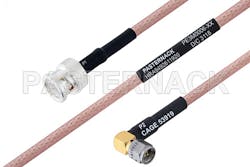MIL-DTL-17 Requirements for Hi-Rel/MIL-SPEC Coaxial Cable Assemblies and a Note on RG Coax
MIL-DTL-17, formerly known as MIL-C-17, is the US military specification (MIL-SPEC) that defines the standards and procedures for qualifying and verifying flexible and semi-rigid coaxial cable for Hi-Rel applications. Because of the rigorous requirements of MIL-DTL-17, many applications that require high reliability (Hi-Rel) coaxial cable may opt for, or require, MIL-DTL-17 coax. There are many requirements and aspects of MIl-DTL-17 coaxial cable, including the following:
• Qualification
• Materials
• Design and construction
• Visual and mechanical
• Operational
• Marking
• Weight
• Workmanship
Hence, a coaxial cable won’t fulfill the MIL-DTL-17 specification unless it meets each category of criteria. Depending on the application, some “Hi-Rel” coaxial cables may call out only specific requirements of the MIL-DTL-17 specification. There are four key areas of inspections detailed in the specification, material, qualification, conformance, and final inspection. Failure at any of these inspections often requires discarding failed parts and/or re-inspection.
As part of these inspections, there are several electrical and mechanical tests that must be performed. Some of these tests are only performed on qualifying batches of coaxial cable, while some tests are performed on each batch of coax to ensure conformance. These tests include:
• Dimensional measurements
• Dielectric withstand voltage
• Shield construction
• Attenuation
• VSWR
• Characteristic impedance
• Conductor adhesion
• Capacitance
• Inductance
Moreover, there are destructive tests performed on sample parts during conformance testing. These tests include:
• Capacitance stability
• Aging stability
• Stress crack resistance
• Outer conductor integrity
• Dimensional stability
• Contamination
• Bendability
• Flammability
• Heat distortion
• Tensile strength and elongation
• Physicals (aged)
Lastly, each coaxial cable is subject to a final inspection, which differs in requirements between semi-rigid cable and flexible cable:
• Semirigid Cable
> Continuity
> Voltage withstanding
• All other Cables
> Continuity
> Spark test
> Voltage withstanding
> Insulation resistance
> Out-of-roundness of jacket measurements
The exact parameters and methods of these tests are detailed in MIL-DTL-17, and/or are further detailed in referenced military and industrial specifications. These tests must also be performed in a qualified facility and the cables tested for qualification and conformance must be produced in the same was as production cables.
Many of the specifications within MIL-DTL-17 are referred to as “RG”, though RG coaxial cables have become a generalized industry term, and not a standardized set of cable specifications. For example, MIL-DTL-17 thoroughly describes maximum attenuation over a range of frequencies, along with precise physical properties, such as conductor plating thickness, and there are no such specifications defining RG coaxial cables. Moreover, a MIL-DTL-17 coaxial cable supplier should have their product on the Qualified Products List (QPL), which isn’t case for readily available RG coax.
Resources

